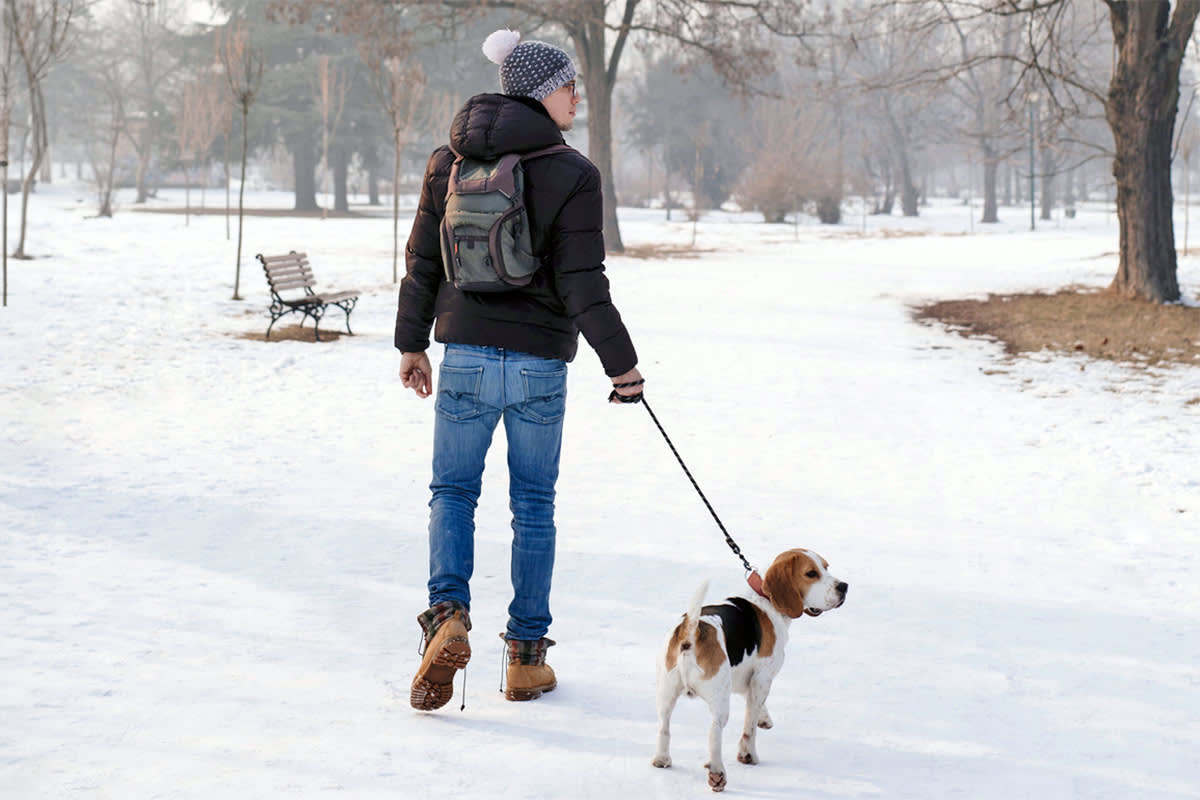Dog-Walking Injuries Are on the Rise—And Your Leash May Be to Blame
Or that phone in your hand.

Share Article
According to researchers at Johns Hopkins Universityopens in new tab, nearly 423,000 adults in the United States went to the emergency room with dog-walking-related injuries between 2001 and 2020. Of those, 75 percent were women, and 43 percent were between the ages of 40 and 64, with 53 being the average. Injuries ranged from sprains and strains (28.3 percent) to finger fractures (6.9 percent) and even traumatic brain injuries (5.6 percent). What’s more, dog-walking-related injuries appear to be on the rise, with nearly four times as many instances occurring in 2020 as in 2001.
Why are all of these injuries happening?
Turns out, a lot of these injuries have to do with the leash. “A leash tethers the dog to the dog walker,” the researchers wrote. “So, a dog’s movements can place substantial or sudden axial traction on the dog walker’s upper extremity (i.e., a pull of the arm away from the body) to cause injury directly to the fingers, hand, wrist, elbow, or shoulder.”
Falls caused by such sudden pulling on the leash (or the tangling of leash around one’s legs) are also a major risk to dog walkers. “Over 50 percent of all patients in the study experienced a fall,” per the researchers. Falls are dangerous for all people. In fact, they are the leading cause of injury-related emergency department visits in almost every adult age group, and the third-leading cause of fatal injuries in the U.S., according to a studyopens in new tab published in the American Journal of Epidemiology. But falls are especially dangerous for those over the age of 65, for whom traumatic brain injuries and hip fractures were the two most common injuries resulting from a fall while walking their dog.
Why such injuries are on the rise is hard to say. There were fewer dogs in 2001 (61.6 millionopens in new tab) than in 2020 (83.3 millionopens in new tab), but not four times fewer. The study’s authors think the increase may have to do with the overall increased physical activity of our aging population, but the way we walk through the world has also changed significantly over the last couple decades. For example, the iPhone was released in 2007, and since then, we’ve been increasingly focused on our screens while walking, which makes us more prone to injury with or without our dogs’ help.

“Distracted walking can certainly contribute to falls and missteps when out walking your dog,” says Stephanie Clark, a physical therapist at Coquitlam Wellness Centreopens in new tab who is not associated with the Johns Hopkins study. However, she has experience working with people recovering from dog-walking related injuries. Sprains and strains are the most common injuries Clark sees, which aligns with the findings of the Johns Hopkins team. But she’s also treated a number of knee injuries, often occurring when a dog unexpectedly bumps into their person on a trail or at the dog park, including torn ACLs.
What should you do to protect yourself (and your dog) while out for a walk?
First and foremost, the researchers suggest making sure your dog is properly trained to “discourage hazardous behavior, such as lunging while leashed.” Proper recall and cues, like “heal,” “leave it,” “look at me,” and “stay” are hugely helpful for maintaining control of your dog on a walk.
“It’s also important that you use the right equipment,” says Jessica Jacobson of Dapper Dog Trainingopens in new tab in New York City. “The most common issue I see is ill-fitting equipment, which can seriously inhibit a dog’s ability to learn.” Jacobson recommends using a front-clipping harness with a snug fit. “These harnesses are designed to stop your dog from pulling, but they won’t work if they are too loose and twist around to the side,” she adds.
Researchers also suggest using a shorter, non-retractable leash to reduce your risk of getting tangled and/or tripped. Jacobson agrees. “I see a lot of people walking their dogs on six-foot leashes, but four-foot leashes are better,” she says. “Six-foot leashes allow too much slack, so if and when the dog starts pulling, the action is more violent and more likely to cause injury.”
Because dogs can move quickly and unpredictably during a walk, researchers suggest holding the leash in the palm of the hand, rather than wrapping it around the fingers or wrist. This will allow you greater control over your dog and give you the ability to loosen or tighten your grip if the dog begins to pull away.
“I also recommend putting a knot in any leash about a foot and a half down from the loop,” Jacobson says. “That way you can hold the knot in your hand and keep the loop around your wrist for added security.”
Jacobson also suggests using a rope leash instead of the more common webbed nylon leashes. “They don’t twist as readily and are thus easier to handle,” she says, “and they are less likely to get tangled around your legs and cause you to fall.”
Here are some useful tips you might not have thought about.
It’s a good idea to keep treats on hand, in case you need to get your dog’s attention and to always be aware of your surroundings, so you are better able to identify and avoid potential triggers for your dog. “Always approach a corner from the far side of the sidewalk,” Jacobson says. “That way you have plenty of room to check and make sure nothing is coming around the corner that might cause your dog to react.”
Jacobson also advises that you stop a few feet back from the edge of the curb when preparing to cross the street. That way there is no danger of your dog getting too close or lunging into the bike lane or oncoming traffic. Don’t let your dog go to the bathroom in the bike lane, either. If a bike approaches while your dog is doing their business, they could get spooked and react and injure all three of you.
You should consider avoiding dogs you don’t know, especially clusters of dogs — like those being walked in a group by a professional dog walker — and dogs that are off leash. “You never know how other dogs will behave or how your own dog will react to them,” Jacobson says. “If another dog lunges at your dog or starts chasing them, you could very quickly get tangled up in the leash and end up hurting yourself.”
Clark, for her part, recommends walking your dog when it is still light out, as many of the injuries she treats are sustained during the wee hours of the morning or at night when visibility is at its worst. She also advises you warm up prior to heading out, and make sure you are wearing sturdy shoes with adequate traction to prevent slips on wet or uneven ground. “Ultimately, staying alert and walking during daylight hours will make a world of difference,” Clark says. “And let’s not underestimate some simple stretching and strengthening exercises. Building resilience is your best defense.”
And if you’ve done all of this, and your dog is still difficult to manage on walks, talk to a trainer and get some specialized help. It’s for your own good.

Charles Manning
Charles Manning is an actor and writer based in New York City. In his free time he likes to cook, go swimming at the public pool, volunteer at the LGBTQ senior center, and foster senior and special-needs cats. His work has previously appeared in Cosmopolitan, Elle, Marie Claire, Harper’s Bazaar, Seventeen, and Nylon.
Related articles
![Person walking their dog in the street]()
How to Leash-Train a Puppy or Dog
Don’t let your new dog walk you.
![A woman walking a dog on a leash and a dog barking at something.]()
Is Your Out-of-Control Dog Lunging on the Leash?
Even a mild-mannered dog can turn into a wild thing when feeling trapped.
![A woman holding a dog outside in the snow]()
How to Keep Your Dog Safe in the Snow
Sometimes, your pup has to be exposed to the elements—and you have to keep them warm when they are. Here’s how.
“How Can I Curb My Dog’s Squirrel Obsession?”
Dog trainer Robert Haussmann’s pro tips for walking a pup that wants to chase everything that moves.
![Woman playing indoors with her big white fluffy dog.]()
8 Fun Ways to Keep Your Dog Entertained Indoors When It’s Freezing Outside
Avoid boredom when cooped up inside all winter.







